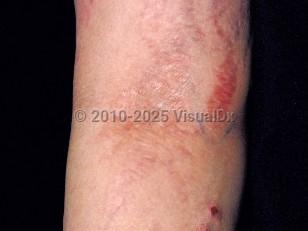Steroid atrophy in Infant/Neonate
See also in: External and Internal EyeAlerts and Notices
Important News & Links
Synopsis

In an infant, steroid atrophy can be seen when diaper dermatitis is treated with potent topical steroids for long periods, and in rarer cases, may lead to Cushing syndrome.
Codes
L90.9 – Atrophic disorder of skin, unspecified
SNOMEDCT:
79983002 – Steroid atrophy
Look For
Subscription Required
Diagnostic Pearls
Subscription Required
Differential Diagnosis & Pitfalls

Subscription Required
Best Tests
Subscription Required
Management Pearls
Subscription Required
Therapy
Subscription Required
Drug Reaction Data
Subscription Required
References
Subscription Required
Last Updated:02/04/2025

